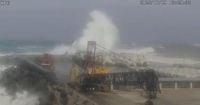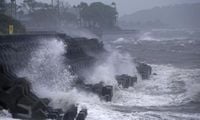On Thursday, October 9, 2025, Typhoon Halong unleashed its fury on a chain of Japanese islands south of Tokyo, battering the region with record-breaking rainfall, fierce winds, and dangerous waves. The Izu Islands, located roughly 280 kilometers (174 miles) from the Japanese capital, bore the brunt of the storm, prompting urgent warnings from government officials and the Japan Meteorological Agency about the risk of landslides and flooding. As the typhoon swept through, hundreds of residents sought refuge in evacuation centers, and travel across the islands ground to a halt.
According to Kyodo news agency, the rainfall that drenched parts of the Izu Islands was unprecedented, setting new records and overwhelming local infrastructure. Hachijo Island, one of the largest in the chain, experienced an especially intense deluge, with rain totals surpassing anything previously recorded, as reported by the Japan Meteorological Agency. The agency also noted the storm’s maximum sustained winds and gusts, though exact figures were not specified in official reports. Nevertheless, the impact was clear: powerful winds and sheets of rain battered homes and businesses, and the threat of sudden, severe flooding loomed large over the entire region.
As the typhoon approached, local authorities issued severe warnings for the Izu Islands, including Hachijō and Aogashima, as well as other islands in the chain such as Toshima, Niijima, Kozushima, Miyakejima, and Mikurajima. Residents were told to be on alert for landslides and the rapid development of “linear rainbands”—narrow corridors of intense rainfall that can cause flash flooding in a matter of minutes. In response to these warnings, hundreds of people moved quickly to official evacuation centers, seeking safety from the worsening conditions.
Images released by the Tokyo Metropolitan Government Bureau of Port and Harbor showed waves crashing violently against the shore of Kaminato Port in Hachijo Island, underlining the storm’s raw power. High waves were also reported in Ibusuki, Kagoshima prefecture, in western Japan, as Typhoon Halong churned its way northward. The Japan Coast Guard, recognizing the danger, instructed vessels to steer clear of the typhoon’s projected path, and all flights and ferries bound for the islands were suspended on Thursday.
Emergency teams were placed on high alert, standing by to respond to potential power outages, road blockages, and other crises. Local officials warned that strong winds could easily down power lines and uproot trees, creating hazardous conditions for anyone venturing outdoors. The threat of landslides was particularly acute, given the saturated ground and steep terrain characteristic of the Izu Islands. As a precaution, the government urged all residents to remain vigilant and heed evacuation orders as the situation evolved.
Tragically, the storm claimed at least one life. In Oiso, Kanagawa prefecture, on the main Japanese island of Honshu, a man was swept away by waves while fishing and did not survive. This fatality underscored the deadly risks posed by the typhoon, even in areas not directly hit by the storm’s core. The authorities reiterated their warnings, emphasizing that the combination of high waves, strong winds, and heavy rain could be life-threatening, particularly along the coast and in low-lying areas.
Despite the intensity of Typhoon Halong, forecasters predicted that the storm would curve eastward over the Pacific later on Thursday, sparing mainland Japan from a direct hit. Nevertheless, the damage and disruption left in its wake were considerable. Power outages, travel delays, and widespread flooding were all anticipated as the storm’s remnants moved away from the islands. Emergency crews remained on standby, ready to assist with recovery efforts and ensure that essential services could be restored as quickly as possible.
The aftermath of Typhoon Halong was not limited to Japan. Meteorological experts warned that the storm’s remnants were likely to merge with a Pacific weather system, intensifying the jet stream toward North America. This so-called “atmospheric teleconnection” was expected to send a surge of moisture and energy toward Western Alaska over the weekend, with the region bracing for heavy rain and strong winds. The storm’s cold air mass was also forecast to push southward into the U.S. West Coast, bringing a chill to states like Washington, Oregon, and California. For California in particular, the forecast called for a multi-day storm, with the Bay Area potentially experiencing its heaviest rainfall since the previous winter and the Sierra Nevada mountains receiving significant early-season snowfall.
Back in Japan, the resilience of the Izu Islands’ residents was on full display. Despite the chaos and anxiety caused by Typhoon Halong, communities came together to support one another, sharing resources and information in evacuation centers. The government and emergency services worked tirelessly to keep people safe, issuing timely updates and coordinating relief efforts. While the storm’s full impact was still being assessed, early reports suggested that the swift response had helped prevent a greater loss of life.
For many in Japan, Typhoon Halong served as a stark reminder of the nation’s vulnerability to extreme weather events. The country’s geography—an archipelago stretching across the Pacific’s volatile “Ring of Fire”—makes it particularly susceptible to typhoons, earthquakes, and other natural disasters. Over the years, Japan has invested heavily in disaster preparedness, building robust warning systems, evacuation routes, and emergency shelters. Even so, the unpredictability of storms like Halong means that residents and officials must always be ready to act quickly.
As the skies began to clear over the Izu Islands and the storm moved out to sea, attention shifted to recovery and rebuilding. Local businesses and families started to assess the damage, while authorities began planning for the restoration of transportation links and power supplies. The experience of Typhoon Halong will no doubt shape future disaster response strategies in Japan, reinforcing the importance of vigilance, cooperation, and resilience in the face of nature’s most formidable challenges.
With the memory of Halong still fresh, communities across Japan and the wider Pacific region are once again reminded of the unpredictable power of the weather—and the enduring strength of those who weather the storm together.

